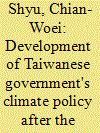|
|
|
Sort Order |
|
|
|
Items / Page
|
|
|
|
|
|
|
| Srl | Item |
| 1 |
ID:
132687


|
|
|
|
|
| Publication |
2014.
|
| Summary/Abstract |
It is well established that GHG emissions must be reduced 50 to 80% by 2050 in order to limit global temperature increase to 2 °C. Achieving reductions of this magnitude in the transportation sector is a challenge and requires a multitude of policies and technology options. The research presented here analyzes three scenarios: changes in the perceived price of travel, land use intensification, and increases in transit. Elasticity estimates are derived using an activity-based travel model for the state of California and broadly representative of the US. The VISION model is used to forecast changes in technology and fuel options that are currently forecast to occur in the US for the period 2000-2040, providing a life-cycle GHG forecast for the road transportation sector. Results suggest that aggressive policy action is required, especially pricing policies, but also more on the technology side, especially increases in the carbon efficiency of medium and heavy-duty vehicles.
|
|
|
|
|
|
|
|
|
|
|
|
|
|
|
|
| 2 |
ID:
132660


|
|
Analysis of monthly household energy consumption among single-f
/ Valenzuela, Carlos; Valencia, Alelhie; White, Steve; Jordan, Jeffrey A, Cano, Stephanie, Keating, Jerome, Nagorski, John, Potter, L.B
|

|
|
|
|
| Publication |
2014.
|
| Summary/Abstract |
Demographic, socioeconomic, and housing characteristics influence variation in household energy consumption. By combining household-level utility, public, and proprietary data, we examine predictors of household energy consumption in a Texas urban area. Using quantile regression, this analysis assesses the relationship between energy consumption and predictors at the middle and both ends of the distribution (10th and 90th percentiles). Results indicate potential opportunities to lower consumption among the highest energy-consuming households including those with pools, with non-central cooling, with people working from home, those built on pier/post foundation, and those that are renter-occupied. These findings suggest significant opportunities to reduce consumption and demand as in the study area, almost 10% of housing units are renter-occupied, 18% percent are without central cooling, and 7% have pools. Capturing a significant portion of these homes for retrofit conservation efforts through marketing has potential to produce substantial results. Producing a better understanding of determinants of household energy consumption using the methods presented has potential to assist development and implementation of strategies to reduce consumption and increase efficiency.
|
|
|
|
|
|
|
|
|
|
|
|
|
|
|
|
| 3 |
ID:
132656


|
|
|
|
|
| Publication |
2014.
|
| Summary/Abstract |
Residential photovoltaic (PV) systems were twice as expensive in the United States as in Germany (median of $5.29/W vs. $2.59/W) in 2012. This price discrepancy stems primarily from differences in non-hardware or "soft" costs between the two countries, which can only in part be explained by differences in cumulative market size and associated learning. A survey of German PV installers was deployed to collect granular data on PV soft costs in Germany, and the results are compared to those of a similar survey of U.S. PV installers. Non-module hardware costs and all analyzed soft costs are lower in Germany, especially for customer acquisition, installation labor, and profit/overhead costs, but also for expenses related to permitting, interconnection, and inspection procedures. Additional costs occur in the United States due to state and local sales taxes, smaller average system sizes, and longer project-development times. To reduce the identified additional costs of residential PV systems, the United States could introduce policies that enable a robust and lasting market while minimizing market fragmentation. Regularly declining incentives offering a transparent and certain value proposition-combined with simple interconnection, permitting, and inspection requirements-might help accelerate PV cost reductions in the United States.
|
|
|
|
|
|
|
|
|
|
|
|
|
|
|
|
| 4 |
ID:
132692


|
|
|
|
|
| Publication |
2014.
|
| Summary/Abstract |
This article presents the results of a survey on the feasibility of, and difficulties in, establishing a locally CSP manufacturing industry in Morocco. First, the survey explores which specific components of the CSP production chain could be manufactured in Morocco today and which would require moderate or significant changes being made in that country over the next decade. This paper contributes to demonstrating the potential for a CSP manufacturing industry in Morocco at the present time, ideal business models and current restrictions. Second, on the one hand this survey provides insight into the entrepreneurial, policy- and market-related barriers hampering the development of this industry and, on the other, the relative advantages offered by Morocco for the development of a CSP sector. Complementing the empirical findings on foreign direct investment determinants, this exercise stresses the key relevance of the economic context not only in terms of size, stability and predictability of the market, but also in regard to the critical importance of institutional and policy-related issues such as stability and public policy commitment. The results show that prior experience of firms in developing areas is a crucial issue in the accurate assessment of the risks and benefits associated with FDI decisions
|
|
|
|
|
|
|
|
|
|
|
|
|
|
|
|
| 5 |
ID:
132644


|
|
|
|
|
| Publication |
2014.
|
| Summary/Abstract |
This paper explores the causal relationship between economic growth, trade openness and energy consumption using data of 15 Asian countries. The study covers the period of 1980-2011. We have applied panel cointegration and causality approaches to examine the long-run and causal relationship between variables.
Empirical results confirm the presence of cointegration between variables. The impact of economic growth and trade openness on energy consumption is found to be positive. The panel Granger causality analysis reveals the bidirectional causality between economic growth and energy consumption, trade openness and energy consumption.
|
|
|
|
|
|
|
|
|
|
|
|
|
|
|
|
| 6 |
ID:
132678


|
|
|
|
|
| Publication |
2014.
|
| Summary/Abstract |
Policy combinations and interactions have received a considerable attention in the climate and energy policy realm. However, virtually no attention has been paid to the analysis of the combination of different deployment instruments for the same renewable energy technology. This neglect is all the more striking given the existence in current policy practice of combinations of deployment instruments either across technologies or for the same technology, both in the EU and elsewhere. What renewable electricity support policies to use and, therefore, how to combine them in order to promote the deployment of renewable energy technologies cost-effectively is a main concern of governments. The aim of this paper is to provide insight on the cost-effectiveness of combinations of deployment instruments for the same technology. A financial model is developed for this purpose, whereby feed-in tariffs (FITs) are combined with investment subsidies and soft loans. The results show that the policy costs of combinations are the same as for the FITs-only option. Therefore, combining deployment instruments is not a cost-containment strategy. However, combinations may lead to different inter-temporal distributions of the same amount of policy costs and, thus, differently affect the social acceptability and political feasibility of renewable energy support.
|
|
|
|
|
|
|
|
|
|
|
|
|
|
|
|
| 7 |
ID:
132682


|
|
|
|
|
| Publication |
2014.
|
| Summary/Abstract |
Coal-fired power plants in China have emitted multiple pollutants including sulfur dioxide, nitrogen oxides and fine particulates, contributing to serious environmental impairments and human health issues. To meet ambient air quality standards, the installation of effective pollution control technologies are required and consequently, the cost of installing or retrofitting control technologies is an important economic and political concern. A multi-pollutant control cost model, CoST CE, is developed to calculate the cost of multi-pollutant control strategies in the Yangtze River Delta region (YRD) of China, adopting an LP algorithm to optimize the sorting of control technology costs and quickly obtain a solution. The output shows that total costs will increase along with emission abatement. Meanwhile, the slope becomes steeper as greater emission reductions are pursued, due to the need to install highly effective, but expensive, technologies like SCR and FF. Moreover, it is evident that the cost curve shapes, maximum abatement potential and total cost for the three provinces in the YRD region are quite different due to differences in power plant type and technologies, current emission levels and existing pollution controls. The results from this study can aid policy makers to develop cost-effective control strategies for the power sector.
|
|
|
|
|
|
|
|
|
|
|
|
|
|
|
|
| 8 |
ID:
132672


|
|
|
|
|
| Publication |
2014.
|
| Summary/Abstract |
We investigate factors influencing country-level renewable energy growth by applying FEVD and PCSE estimation methods in a unique sample analysis. With a longer time series (1990-2010) and a broader sample size of countries (including Brazil, Russia, India, China and South Africa) than previous studies, our results reveal new insights. The results suggest that certain government-backed energy policies impede renewable energy investments, thus implying significant failures in policy design. These policies may be failing mainly because of uncertainty and the likelihood of discontinuity. Weak voluntary approaches are introduced in order to satisfy public demand for more sustainable investments and programmes; we find that these may have negative influences on the growth of renewables as well. The insight gained is consistent over the estimation methods employed.
|
|
|
|
|
|
|
|
|
|
|
|
|
|
|
|
| 9 |
ID:
132646


|
|
|
|
|
| Publication |
2014.
|
| Summary/Abstract |
This article offers the first national examination of the determinants of adoption of wind and solar energy generation on U.S. farming operations. The inclusion of state policies and characteristics in a multilevel modeling approach distinguishes this study from past research utilizing logit models of technology adoption which focus only on the characteristics of the farm operation. Results suggest the propensity to adopt is higher for livestock operations, larger farms, operators with internet access, organic operations, and newer farmers. The results find state characteristics such as solar resources, per capita income levels, and predominantly democratic voting increasing the odds of farm adoption. This research suggests the relevance of state policy variables in explaining farm level outcomes is limited, although in combination best practice net metering and interconnection policies-policies designed to encourage the development of small scale distributed applications-are shown to increase the likelihood of farm solar and wind adoption. The prevalence of electric cooperatives-which are often not subject to state renewable energy policies and often service farms-is negatively related with the propensity to adopt and suggests that policy design may be a factor
|
|
|
|
|
|
|
|
|
|
|
|
|
|
|
|
| 10 |
ID:
132680


|
|
|
|
|
| Publication |
2014.
|
| Summary/Abstract |
Surrogate models are an important part of building energy labelling programs, but these models still present low accuracy, particularly in cooling-dominated climates. The objective of this study was to evaluate the feasibility of using an artificial neural network (ANN) to improve the accuracy of surrogate models for labelling purposes. An ANN was applied to model the building stock of a city in Brazil, based on the results of extensive simulations using the high-resolution building energy simulation program EnergyPlus. Sensitivity and uncertainty analyses were carried out to evaluate the behaviour of the ANN model, and the variations in the best and worst performance for several typologies were analysed in relation to variations in the input parameters and building characteristics. The results obtained indicate that an ANN can represent the interaction between input and output data for a vast and diverse building stock. Sensitivity analysis showed that no single input parameter can be identified as the main factor responsible for the building energy performance. The uncertainty associated with several parameters plays a major role in assessing building energy performance, together with the facade area and the shell-to-floor ratio. The results of this study may have a profound impact as ANNs could be applied in the future to define regulations in many countries, with positive effects on optimizing the energy consumption.
|
|
|
|
|
|
|
|
|
|
|
|
|
|
|
|
| 11 |
ID:
132668


|
|
|
|
|
| Publication |
2014.
|
| Summary/Abstract |
Given its limited involvement in and recognition by international organizations, Taiwan is not presently a signatory to the United Nations Framework Convention on Climate Change (UNFCCC) or the Kyoto Protocol. The objective of this study is to analyze how and the extent to which changes in an exogenous factor, namely the Kyoto Protocol and Post-Kyoto climate negotiations, affect and ultimately lead to the formulation of and changes in the Taiwanese government×s climate policy. This study applies policy network theory to examine the development of and changes in the Taiwanese government×s climate policy. The results demonstrate that international climate agreements and negotiations play a key role in the development of, changes to, and transformation of Taiwan×s climate policy. Scarce evidence was found in this study to demonstrate that domestic or internal factors affect climate change policy. Despite its lack of participation in the UNFCCC and the Kyoto Protocol, Taiwan has adopted national climate change strategies, action plans, and programs to reduce greenhouse gas emissions. However, these climate policies and measures are fairly passive and aim to only conform to the minimal requirements for developing countries under international climate agreements and negotiations. This process results in inconsistent and variable climate policies, targets, and regulations.
|
|
|
|
|
|
|
|
|
|
|
|
|
|
|
|
| 12 |
ID:
132658


|
|
|
|
|
| Publication |
2014.
|
| Summary/Abstract |
Renewable energy technologies (RETs) have attracted significant public attention for several reasons, the most important being that they are clean alternative energy sources that help reduce greenhouse gas emissions. To increase the probability that RETs will be successful, it is essential to reduce the uncertainty about its adoption with accurate long-term demand forecasting. This study develops a diffusion model that incorporates the effect of competitive interrelationships among renewable sources to forecast the growth pattern of five RETs: solar photovoltaic, wind power, and fuel cell in the electric power sector, and solar thermal and geothermal energy in the heating sector. The 2-step forecasting procedure is based on the Bayus, (1993. Manage. Sci. 39, 11, 1319-1333) price function and a diffusion model suggested by Hahn et al. (1994. Marketing Sci. 13, 3, 224-247). In an empirical analysis, the model is applied to the South Korean renewable energy market.
|
|
|
|
|
|
|
|
|
|
|
|
|
|
|
|
| 13 |
ID:
132651


|
|
|
|
|
| Publication |
2014.
|
| Summary/Abstract |
This paper uses Q methodology to reveal stakeholder perceptions on how best to address energy issues in Africa. We sampled a group of stakeholders involved in various energy sub-sectors to uncover perspectives on how to achieve and promote access to modern energy, energy efficiency and renewable energy in Africa, whether the perceptions could be correlated to educational or geographical background and implications such patterns could have on policies and current dialogues.
We found that all stakeholders agree on the need to prioritise sustainability but had different views on how to achieve sustainable energy for all in Africa, depending on the relevance given to each energy driver. Stakeholders could be categorised into four groups: (I) preference of large-scale high-impact projects; (II) supporters of targeted sectoral solutions with preference for small-scale technology and microfinance; (III) supporters of centralised solutions with preference for grid extension, and (IV) supporters of local entrepreneurship with scepticism about centralised solutions. The results show that differences in stakeholders' perceptions can be associated with respondents' educational but not geographical background. This implies that dialogues on energy in Africa should focus on inter-disciplinary understanding while further examining the trans-continent consensus that appears to have been established.
|
|
|
|
|
|
|
|
|
|
|
|
|
|
|
|
| 14 |
ID:
132677


|
|
|
|
|
| Publication |
2014.
|
| Summary/Abstract |
In this paper we analyze the effect of regional and municipal measures for promoting energy transition on citizen attitudes and behavior. We compare one township that has successfully implemented a comprehensive and systematic energy-saving program (the so-called e5 program) with a township without such a program. The results indicate that despite the program×s ambitious aims, e5 implementation has almost no impact on citizen attitudes and behavior. In fact, there are some signs that it might even have slight negative side effects.
|
|
|
|
|
|
|
|
|
|
|
|
|
|
|
|
| 15 |
ID:
132685


|
|
|
|
|
| Publication |
2014.
|
| Summary/Abstract |
The aim of this paper is to examine whether shareholders consider the EU Emissions Trading Scheme (EU ETS) as value-relevant for the participating firms. An analysis is conducted of the share prices changes as caused by the first publication of compliance data in April, 2006, which disclosed an over-allocation of emission allowances. Through an event study, it is shown that share prices actually increased as a result of the allowance price drop when firms have a lower carbon-intensity of production and larger allowance holdings. There was no significant value impact from firms× allowance trade activity or from the pass-through of carbon-related production costs (carbon leakage). The conclusion is that the EU ETS does 'bite'. The main impact on the share prices of firms arises from their carbon-intensity of production. The EU ETS is thus valued as a restriction on pollution.
|
|
|
|
|
|
|
|
|
|
|
|
|
|
|
|
| 16 |
ID:
132676


|
|
|
|
|
| Publication |
2014.
|
| Summary/Abstract |
This paper argues that electricity 'curtailment' behaviors (i.e. frequent and/or low cost or free energy saving behaviors) in households are distinct from one another and they thus should be analyzed and promoted. We test this claim with data from telephone interviews with Greek households in the capital city of Athens (N=285), analyzing the impact of a number of demographical/structural, psychological (based on the Theory of Planned Behavior) and moral (based on norms' activation) predictors though hierarchical binary logistic regression modeling. We find that that each electricity curtailment behavior depends on a different mix of predictors with 'Age', 'Gender' and 'Perceived Behavioral Control' being statistically significant for most behaviors. Overall, the psychological and the demographical/structural clusters of variables substantially contribute to the explained variance of electricity curtailment behaviors. The moral cluster×s contribution is not statistically significant since moral concerns are largely interwoven in the psychological constructs.
|
|
|
|
|
|
|
|
|
|
|
|
|
|
|
|
| 17 |
ID:
132669


|
|
|
|
|
| Publication |
2014.
|
| Summary/Abstract |
Local citizen-led initiatives relating to energy are developing strongly in Anglo-Saxon countries and a growing body of research is examining their innovative potential. In France, similar grassroots initiatives - albeit with certain specificities - only began to emerge recently and so far, very few studies have dealt with them. The purpose of this article is to propose an exploratory and in-depth analysis of one advanced French case: Le Mené, a pioneer in local energy autonomy. We examine the conditions under which the initiative emerged and the processes through which a grassroots innovation is formed. In studying this case (interviews, analysis of documents), comparing it with other sources of data (expert interviews, comparative observation of other initiatives) and taking stock of various social sciences studies, we show that a social innovation was produced in Le Mené through the hybridisation of actors, sociotechniques and discourses. This initiative was innovative not only in terms of the scope of the mechanisms implemented, but also in terms of the social organisation behind the development of the projects and the capacity to use energy production as a social resource. Finally, we reflect on the possible diffusion of these grassroots initiatives and their policy implications in France.
|
|
|
|
|
|
|
|
|
|
|
|
|
|
|
|
| 18 |
ID:
132671


|
|
|
|
|
| Publication |
2014.
|
| Summary/Abstract |
In the objective of reaching the "nearly zero-energy buildings" target set by the European Union, municipalities cover a crucial role in advocating and implementing energy-efficient measures on a local scale. Based on a dataset of 322 municipalities in Northern Italy, we carried out a statistical analysis to investigate which factors influence the adoption of energy efficiency in municipal buildings. In particular, the analysis focuses on four categories of factors: (i) capacity building for energy efficiency, (ii) existing structure and competences for energy efficiency, (iii) technical and economic support for energy efficiency, and (iv) spill-over effect caused by adoption of "easier" energy-efficient measures. Our results show that capacity building through training courses and technical support provided by energy audits affect positively the adoption of energy efficiency in municipal buildings. The size of the municipal authority, the setting of local energy policies for residential buildings and funding for energy audits are not correlated with energy efficiency in public buildings, where the "plucking of low hanging fruit" often prevails over more cost-effective but long-term strategies. Finally, our results call for the need to promote an efficient knowledge management and a revision of the Stability and Growth Pact.
|
|
|
|
|
|
|
|
|
|
|
|
|
|
|
|
| 19 |
ID:
132667


|
|
|
|
|
| Publication |
2014.
|
| Summary/Abstract |
The article focuses on the interplay between two factors giving rise to friction in bioenergy governance: profound value disagreements (e.g. the prioritizing of carbon concerns like worries over GHG emissions savings over non-carbon related concerns) and regulatory complexity (in terms of regulatory measures and options). We present ethical and legal analyses of the current stalemate on bioenergy governance in the EU using two illustrative cases: liquid biofuels for transport and solid biomass-based bioenergy. The two cases disclose some similarities between these two factors, but the remaining differences may partly explain, or justify, contrasting forms of governance. While there seems to be no easy way in which the EU and national governments can deal with the multiple sustainability issues raised by bioenergy, it is argued that failure to deal explicitly with the underlying value disagreements, or to make apparent the regulatory complexity, clouds the issue of how to move forward with governance of bioenergy. We suggest that governance should be shaped with greater focus on the role of value disagreements and regulatory complexity. There is a need for more openness and transparency about such factors, and about the inherent trade-offs in bioenergy governance.
|
|
|
|
|
|
|
|
|
|
|
|
|
|
|
|
| 20 |
ID:
132674


|
|
|
|
|
| Publication |
2014.
|
| Summary/Abstract |
After the Fukushima nuclear accident, more and more attention has been paid to the safety issues of nuclear power in China, even though it is a clean and necessary substitution to coal power. Due to the consideration about the uncertainty of nuclear safety, the local citizens may resist the nuclear power programs in their neighborhood, as indicated by the anti-nuclear movement in Jiangmen 2013. This phenomenon is often related to the public perceptions of "not-in-my-back-yard" (NIMABY). The explosion of anti-nuclear movements will impose adverse effects on the nuclear power decision-making in China. Based on the Contingent Valuation Method (CVM), we evaluate the public Willingness-To-Pay (WTP) for avoiding the construction of nuclear power plants in their neighborhood. Moreover, we analyze whether more information about nuclear energy could improve the public acceptance. Our results show that the comprehensive information will decrease the public risk perception of nuclear power and increase the public support for nuclear power policy. This paper further suggests that China×s decision makers should improve policy transparency and encourage the public involvement of nuclear energy decision making.
|
|
|
|
|
|
|
|
|
|
|
|
|
|
|
|
|
|
|
|
|